Microsoft’s Surface Pro 8 has reigned supreme as the best detachable 2-in-1 laptop around and made its way to our list of best laptops overall. It’s a redesign that brought slimmer display bezels and a larger 13-inch display, along with faster components and Thunderbolt 4 ports.
The Surface Pro 8 has some new competition, though. Dell has announced the first detachable tablet in its XPS line, replacing the previous 360-degree convertible design. The XPS 13 2-in-1 offers Intel 12th-gen CPUs and a competitive design. Can it overtake the Surface Pro 8?

Specs
| Dell XPS 13 2-in-1 | Microsoft Surface Pro 8 | |
| Dimensions | 11.5 inches x 7.9 inches x 0.28 inches 0.31 inches with 5G |
11.3 inches x 8.2 inches x 0.37 inches |
| Weight | 1.6 pounds (tablet only) 1.8 pounds (tablet only) with 5G |
1.96 pounds (tablet only) |
| Processor | Core i5-1230U Core i7-1250U |
Core i5-1135G7 Core i7-1185G7 |
| Graphics | Intel Iris Xe | Intel Iris Xe |
| RAM | 8GB 16GB |
8GB 16GB 32GB |
| Display | 13-inch 3:2 IPS 3K (2,880 x 1,920) | 13-inch 3:2 IPS 3K (2,880 x 1,920) |
| Storage | 256GB PCIe SSD 512GB PCIe SSD 1TB PCIe SSD |
128GB PCIe SSD 256GB PCIe SSD 512GB PCIe SSD 1TB PCIe SSD |
| Touch | Yes | Yes |
| Ports | 2 x USB-C with Thunderbolt 4 1 x USB-C to USB-A adapter 1 x USB-C to 3.5mm audio adapter |
2 x USB-C with Thunderbolt 4 1 x Surface Connect 3.5mm audio jack Surface Type Cover MicroSD Card reader |
| Wireless | Wi-Fi 6E and Bluetooth 5.2 Optional 5G WWAN |
Wi-Fi 6 and Bluetooth 5.1 |
| Webcam | Full HD | Full HD |
| Operating system | Windows 11 | Windows 11 |
| Battery | 49.5 watt-hour | 51.5 watt-hour |
| Price | TBD | $1,100+ |
| Rating | Not reviewed | 4 out of 5 stars |
Design
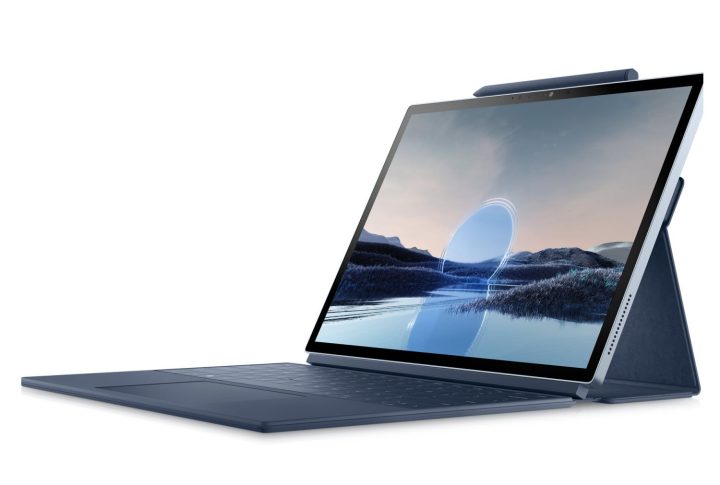
As mentioned in the introduction, the Surface Pro 8 is a significant redesign over the tablet’s previous generations. It’s made of aluminum rather than magnesium, its edges are a bit more rounded, and the display was upgraded from 12.3 inches to 13 inches. A reduction in display bezel size allowed Microsoft to keep the tablet almost the same size despite the larger display. You can get the Surface Pro 8 in either Graphite (black) or Platinum (silver) color schemes, and other than the iconic kickstand that opens from the center of the tablet’s backside, it’s a typical slate in appearance. The Surface Pro 8’s build quality is exceptional, with no gaps or unsightly seams and with a solid feel of metal fused with glass. No tablet’s better constructed.
The Dell XPS 13 2-in-1 is also constructed of aluminum and is a very minimalist design. It follows the XPS line’s example by using smaller bezels than the Surface Pro 8, but even so, it’s the tiniest bit wider than Microsoft’s tablet while being a little shorter. It offers two colors, Sky (blue) and Slate (dark gray), and overall it, too, is a pretty standard slate design with edges that are sharper than the Surface Pro 8’s.
The Surface Pro 8 is thicker than the XPS 13 2-in-1 at 0.37 inch versus 0.28 inch and heavier at 1.96 pounds versus 1.6 pounds. The 5G version of the XPS 13 2-in-1 (more on that below) is slightly thicker than the Wi-Fi-only version at 0.31 inch and heavier at 1.8 pounds.
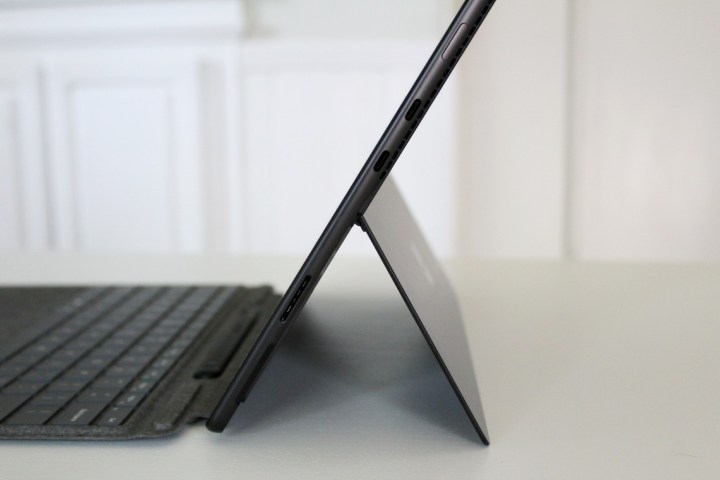
While the Surface Pro 8 has its kickstand built in, the XPS 13 2-in-1 depends on its optional Folio detachable keyboard to prop it up. It offers just three angles (110 degrees, 112.5 degrees, and 125 degrees) compared to the Surface Pro 8’s unlimited range from almost straight up to lying almost flat. Microsoft Signature Type Cover is also one of the best typing experiences around, with large keycaps and sufficient key spacing and a switch mechanism that’s light and snappy. The Dell Folio keyboard offers an edge-to-edge, zero-lattice design that we’ll have to reserve judgment about until we’ve had a chance to check it out. Both detachable keyboards offer touchpads that support Microsoft Precision drivers for Windows 11 multitouch gesture support.
Both tablets support an active pen, but the Surface Pro 8 offers a bonus. It supports the haptic feedback built into the Surface Slim Pen 2, which, when combined with the 120Hz refresh rate, makes for the most realistic inking experience around. The Surface Slim Pen 2 slots into a holder on the keyboard that keeps it in place while charging it, while the XPS 13 2-in-1’s pen is magnetically attached at the top to recharge. Dell includes Tile functionality built into the pen to help locate it either locally via Bluetooth or on a map via the anonymous Tile Network.
The Surface Pro 8 offers two USB-C ports with Thunderbolt 4 support, a Surface Connect port for charging and connecting to Microsoft peripherals, a 3.5mm audio jack, and a microSD card reader. The XPS 13 2-in-1 has more limited connectivity, with just two USB-C ports with Thunderbolt 4. There’s no 3.5mm audio jack built in, but Dell does supply a USB-C to 3.5mm audio adapter along with a USB-C to USB-A adapter.
The XPS 13 2-in-1 has the newer and faster Wi-Fi 6E and Bluetooth 5.2 compared to the Surface Pro 8’s Wi-Fi 6 and Bluetooth 5.1. In addition, the XPS 13 2-in-1 will be available with 5G WWAN connectivity via an eSIM that can connect with any carrier.
Performance
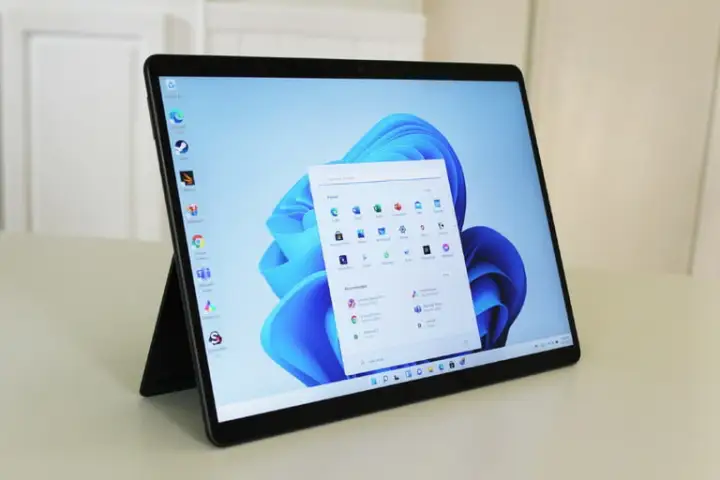
The Dell XPS 13 2-in-1 equips Intel’s latest 12th-gen CPUs, specifically the lower-power U-series Core i5-1230U and Core i7-1250U. These are 10-core (2 Performance and 8 Efficient), 12-thread CPUs running at a base power of 9 watts, with the Core i7 being clocked faster than the Core i5. We haven’t benchmarked this processor yet, so we can’t compare its performance to the 11th-gen 28-watt, 4-core/8-thread Core i5-1135G7 and Core i7-1185G7 CPUs in the Surface Pro 8.
Across the board, the Surface Pro 8 with the Core i7 was competitive with other 11th-gen laptops but fell behind newer machines with the Core i7-1260P, a 12-core (4 Performance and 8 Efficient), 16-thread CPU running at 28 watts. We’re looking forward to pitting the XPS 13 2-in-1 against the Surface Pro 8 to see if Intel’s lower-power CPUs can keep up with faster previous-gen processors.
Both tablets utilize Intel’s Iris Xe graphics. We haven’t noticed any significant improvement in the 12th-gen version, and so neither 2-in-1 is going to do more than play less-demanding games at lower resolutions and graphics settings.
Display
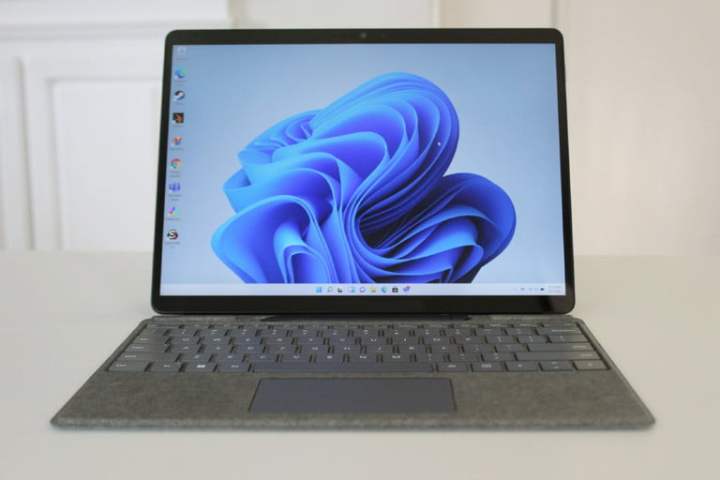
Both tablets have similar 13-inch 3:2 3K (2,880 x 1,920) touch displays. In our testing, the Surface Pro 8’s version was bright at 405 nits, offered average color width at 99% of the sRGB gamut and 79% of the AdobeRGB gamut, and good accuracy at a DeltaE of 1.29 (1.0 or less is considered excellent).
Its contrast just exceeded our preferred 1000:1 ratio at 1,010:1. It’s a great display for productivity work and consuming media, but its colors aren’t quite wide enough for serious creative work. The Surface Pro 8’s display also supports a refresh rate of 120Hz, making Windows 11 a smoother experience.
Dell touts 500 nits of brightness for the XPS 13 2-in-1 with 100% sRGB coverage and an 1,800:1 contrast ratio. We’ll have to test the display with our colorimeter to be sure, but these numbers imply slightly better performance than Microsoft’s display. We’re not sure about the display’s refresh rate, but for now, we’ll assume it’s a pedestrian 60Hz.
Portability
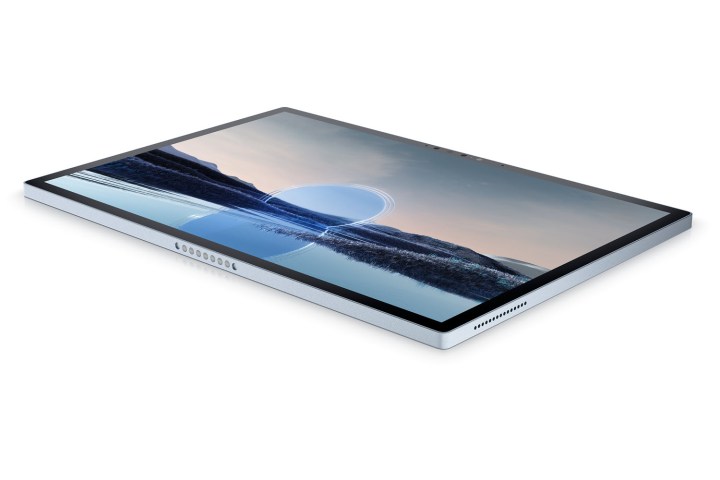
The Dell XPS 13 2-in-1 is slightly thinner and lighter than the Surface Pro 8, but both can be tossed into a backpack and carried around without noticing them. They both add weight when they include their detachable keyboards, but they’re still lighter than the average 13-inch laptop.
The Surface Pro 8 has 51.5 watt-hours of battery capacity versus the XPS 13 2-in-1’s 49.5 watt-hours. However, the Dell utilizes low-power CPUs that, on paper at least, should give it an advantage in battery life. The Surface Pro 8 provided slightly below-average battery life in our testing but still decent for a tablet. Once again, we’ll have to wait for our official review to draw any conclusions.
For now, it’s a toss-up
The Surface Pro 8 starts at $900 for a Core i5, 8GB of RAM, and a 128GB solid-state drive. It tops out at $2,600 for a Core i7, 32GB of RAM, and a 1TB SSD. It, therefore, ranges from affordable to extremely expensive.
The XPS 13 2-in-1 will be launched in summer 2022. Dell has yet to confirm pricing.
For now, we can’t say which of these detachable tablets is the best just yet, but the Surface Pro certainly has a new challenger on its hands.
Editors' Recommendations
- Surface Pro 10: all the major changes rumored for the new model
- 9 best 2-in-1 laptops in 2024: tested and reviewed
- The best 2-in-1 gaming laptops for 2024
- Should you buy the Surface Laptop Studio or wait for the Surface Laptop Studio 2?
- Can you use the Surface Pen with the Surface Laptop Studio 2?


